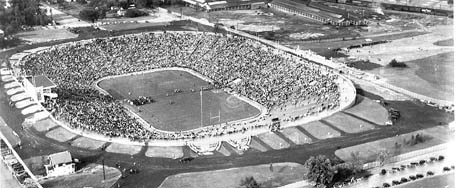With more Wolverine fans over the years, U-M Stadium has grown with the times
Date Posted: March 5 2004
ANN ARBOR – Renovated and expanded over the years, the University of Michigan Stadium today has one of the nation’s largest seating capacities for football stadiums – but it could have been called “The Big House” even when it was opened in 1927.
U-M Regents approved a plan for the construction of the stadium in 1925. University planners said it should be designed with “the utmost simplicity” – and the design was eventually a big bowl that would seat 72,000. Fielding Yost, the U-M athletic director at the time, wisely pushed for a construction plan that would allow for the expansion of the stadium to seat up to 150,000 fans.
The stadium construction site utilized the natural slope of the farmland upon which it was built. Using steam shovels, trucks, and horses and wagons, 200 tradesmen removed as much as 2,000 cubic yards of dirt a day, digging down about 50 feet from the surface. However, excavation contractors ran into so much difficulty with an underground spring at the site that they had to raise the field by six feet. Legend had it that a steam shovel is still buried below the playing field, after it sank in the muck.
Construction workers poured 11,000 yards of cement and installed 440 tons of reinforcing iron. As the stadium was being completed in time for the 1927 season, 22 miles of redwood plank seats were installed. The total price tag for U-M stadium was $1.1 million.
There have been 35 million fans over the years who have watched the Wolverines play football at the “Field That Yost Built,” and 170 consecutive crowds of more than 100,000 fans. Over the years, most recently in 1998, the stadium’s seating capacity has been upped and is now at 107,501.
(Information/photos from the U-M Bentley Historical Library)

The new U-M Stadium in 1927.
